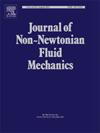Dam break of viscoplastic elliptical objects
IF 2.8
2区 工程技术
Q2 MECHANICS
引用次数: 0
Abstract
In this note, we numerically and theoretically analyze the physical mechanisms controlling the gravity-induced spreading of viscoplastic elliptical metric objects on a sticky solid surface (without sliding). The two-dimensional collapsing objects are described as Bingham fluids. The numerical simulations are based on a variational multi-scale approach devoted to multiphase non-Newtonian fluid flows. The results are depicted by considering the spreading dynamics, energy budgets, and new scaling laws. They show that, under negligible inertial effects, the driving gravitational energy of the elliptical columns is dissipated through viscoplastic effects during the collapse, giving rise to three flow regimes: gravito-viscous, gravito-plastic, and mixed gravito-visco-plastic. These regimes are strongly affected by the initial aspect ratio of the collapsing column, which reveals the possibility of using morphology to control spreading. Finally, the results are summarized in a diagram linking the object’s maximum spreading and the collapse time with different collapsing regimes through a single dimensionless parameter called collapse number.
大坝溃坝的粘塑性椭圆物体
在本文中,我们从数值和理论上分析了控制粘塑性椭圆物体在粘性固体表面(无滑动)上的重力诱导扩散的物理机制。二维坍缩的物体被描述为宾厄姆流体。数值模拟是基于一种致力于多相非牛顿流体流动的变分多尺度方法。通过考虑扩展动力学、能量预算和新的标度定律来描述结果。结果表明,在可忽略惯性效应的情况下,椭圆柱的驱动重力能在坍塌过程中通过粘塑性效应耗散,产生三种流动形式:重力-粘性、重力-塑性和重力-粘塑性混合流动。这些区域受到坍塌柱的初始宽高比的强烈影响,这揭示了利用形态来控制扩散的可能性。最后,通过一个称为崩溃数的无量纲参数将不同崩溃状态下物体的最大扩展与崩溃时间联系起来,并将结果总结为一个图表。
本文章由计算机程序翻译,如有差异,请以英文原文为准。
求助全文
约1分钟内获得全文
求助全文
来源期刊
CiteScore
5.00
自引率
19.40%
发文量
109
审稿时长
61 days
期刊介绍:
The Journal of Non-Newtonian Fluid Mechanics publishes research on flowing soft matter systems. Submissions in all areas of flowing complex fluids are welcomed, including polymer melts and solutions, suspensions, colloids, surfactant solutions, biological fluids, gels, liquid crystals and granular materials. Flow problems relevant to microfluidics, lab-on-a-chip, nanofluidics, biological flows, geophysical flows, industrial processes and other applications are of interest.
Subjects considered suitable for the journal include the following (not necessarily in order of importance):
Theoretical, computational and experimental studies of naturally or technologically relevant flow problems where the non-Newtonian nature of the fluid is important in determining the character of the flow. We seek in particular studies that lend mechanistic insight into flow behavior in complex fluids or highlight flow phenomena unique to complex fluids. Examples include
Instabilities, unsteady and turbulent or chaotic flow characteristics in non-Newtonian fluids,
Multiphase flows involving complex fluids,
Problems involving transport phenomena such as heat and mass transfer and mixing, to the extent that the non-Newtonian flow behavior is central to the transport phenomena,
Novel flow situations that suggest the need for further theoretical study,
Practical situations of flow that are in need of systematic theoretical and experimental research. Such issues and developments commonly arise, for example, in the polymer processing, petroleum, pharmaceutical, biomedical and consumer product industries.

 求助内容:
求助内容: 应助结果提醒方式:
应助结果提醒方式:


